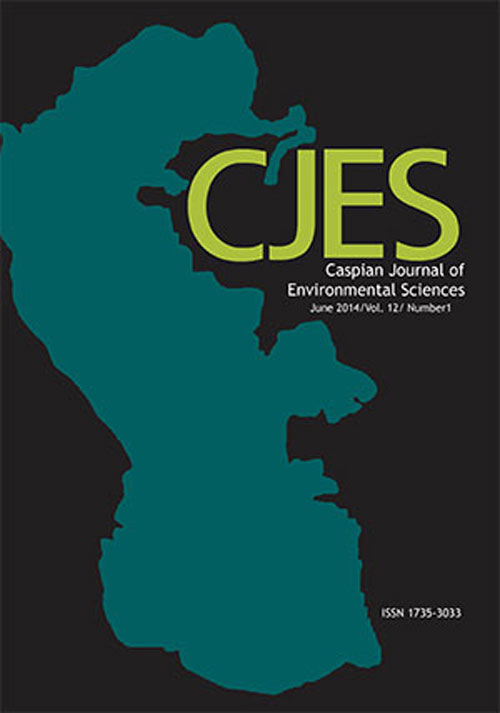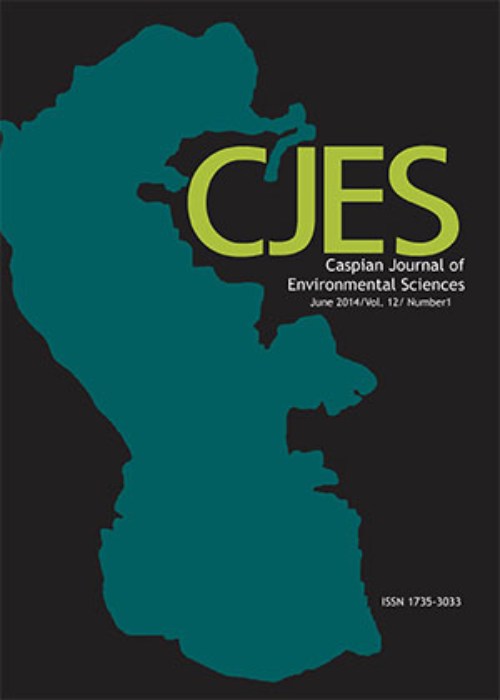فهرست مطالب

Caspian Journal of Environmental Sciences
Volume:15 Issue: 1, Winter 2017
- تاریخ انتشار: 1396/01/16
- تعداد عناوین: 8
-
-
Pages 1-11The aim of this study was to degrade furfural by a new nanotube system. To degrade some organic pollutants as well as to reduce the amount of furfural which is a well-known pollutant in oil industry, the photocatalytic process along with ultraviolet (UV) irradiation may be employed. In this study, the UV/TiO2/Pd system in which the nanoparticles of palladium doped into the titanium dioxide was proposed for degradation of furfural. The rate of furfural decomposition in the proposed system was more than that of the system without TiO2 foils due to the degradable reactions. The experimental results demonstrate that the maximum degradation occurs at a distinct pH and specific temperature under the UV irradiation. After 100-minute UV-irradiation duration, the maximum and minimum degradations were 97.8% (pH 3), and 95.8% (pH 12), respectively. Also, the degradation values were as parabolic function at the pH values. The values of efficiency of decomposition for this irradiation duration at optimum pH 3 were 96.7% and 98.5% at 30◦C and 40◦C, respectively. Also, the minimum degradation under photolysis was 93.52% at 30oC under 20-minute UV-irradiation duration. Furthermore, while the irradiation duration was 70-75 min, the degradation values were independent of pH approximately. The difference between the degradation values at 30 and 40◦C was decreased with increasing the UV-irradiation duration till 60min, and then this difference was increased with increasing the UV-irradiation duration.Keywords: Furfural, UV-TiO2-Pd system, Photocatalytic degradation, Temperature, pH
-
Pages 13-27Damage to residual stand is unavoidable and it is one of the main important issues in the forest harvesting. Trees damage may occur in felling and skidding work phase or during skid trail construction. In any case, damage can be very serious to residual stand. Detailed study is necessary to find out the amount and severity of damage to trees; therefore district 14 of Kilesara in Guilan Province, Iran was selected for the study. The cut-to-length and the tree - length methods are practiced in the Hyrcanian forest. Applying any of these two methods is mostly related to dimensions of woody material, technical characteristics of skid trail, and machinery availability. A residual stand which is left after practicing such a method, is damaged in different way which needs to be studied in detail. The length of the winching strips and skid trails differed, but the width of them was kept constant at 6 m (3 m distance from centerline of winching strips or borderline of skid trails). All trees and regenerations around winching strips and skid trails are investigated for finding any sign of damage or injuries. The results showed that along winching strips, the percentage of damage to the residual stand was 19.5 and 18 %, while the damages along skid trails reached 25.4 and 31 % in the tree length and cut-to-length methods, respectively. The results of this study suggest that damage to the residual stand is considerable and should be reduced in order to improve the quality of stand at future.Keywords: Damage to residual stand, Post harvesting assessment, Skid trail, Winching strip, Iran
-
Pages 29-46To be successful in tree establishment, an assessment of land suitability would be necessary. The aim of this study was determining the potential habitats of three native tree species (Quercus persica, Pistacia atlantica, Amygdalous scoparia) in Siahkoh region of Ilam County, using Boolean method and Geographic Information Systems (GIS). For this regard, the slope, aspect and hypsometric maps of the area were produced using topographic maps. To provide soil properties maps, 40 soil samples in depth of 30 cm were randomly taken from the defined region (about 954 ha). Soil sample properties such as pH, texture, electrical conductivity, and organic material were measured. Soil maps and soil data layers were produced in GIS environment. With respect to ecological needs of the selected tree species and combining of all provided maps, about 890 ha of the total area could be reforested or afforested. The results show that from the total suitable area, 368.72 ha (41.41 %) for Quercus persica, 353.44 ha (36.69 %) for Pistacia atlantica and 176.2 ha (19.78 %) for Amygdalus scoparia were found to be suitable for these species. The results of comparing the extracted suitability map with the existing 30 ha afforestation in the region show that, from 10 hectares afforested by each species, Quercus persica, Pistacia atlantica and Amygdalus scoparia 7.65, 3.11 and 4.25 ha are located in the high suitable areas, respectively.Keywords: Native species, Suitable areas, GIS, Forestation
-
Pages 47-55Forest roads are the most important elements of forestry projects, the management, supervision, care, and only access way to the forest for mechanized harvesting and using other services of forests. The aim of this study was to compare the current annual increment of basal area in different distances from the road in northern forests of Iran. For this purpose, 50 plots were established in 5 distance classes (0-10, 10-20, 20-30, 30-40, and 40-50 m) on the 10 perpendicular transects to the forest road. In each plot current annual increment of basal area of 6 trees were measured by trunk core samples. Results of ANOVA test showed that there is no significant difference among the current annual increment of basal area in different distance classes from the roads. The results also showed that with increasing of distance from the roads into forest interior, current annual increment of basal area were reduced. The UNIANOVA test showed that there was a significant difference between interaction distance classes and diameter classes on current annual ring and diameter increment (p= 0.00).Keywords: Adjacent Stand, Increment of Basal Area, Transect, Tree Diameter Growth
-
Pages 57-66Modification of stands structure and managing them using silvicultural methods close to nature and single selection system require information on status of structure, determining the target diameter, basal area and suitable volume to result in long-term equilibrium and sustainability. So, this study was conducted using the selection sample statistical method by selecting five 1-ha sample plots in mixed oriental beech Fagus orientais Lipsky forests of Asalem watershed, located in the west of Guilan Province, Northern Iran. Quantitative and qualitative features of the studied stand were recorded in relation to each sample plot. The results from analysis of the curves related to diameter classes, volume and basal area of the stands with their annual growth showed that 26 to 28 m2.ha-1 and a volume of 300 to 350 m3.ha-1 with a target diameter of 75-80 cm was suggested for the purposeful removal and avoiding taste markings in order to modify and guide the structures of Northern Irans oriental beech stands.Keywords: Beech, Mixed stand, Northern iran, Stand structure, Target diameter
-
Pages 67-74A forest area in Deh-Kohneh, the northwest of Fars Province, Iran was studied from a floristic and ecological point of view. The species were classified according to their growth habit. Raunkiaers life - forms systemwere used to characterize the flora of the study area. The location has a surface area of 466 ha by minimum altitude at 2100m and maximum at 2554m, between 30 ° 21΄ 32˝ to 30° 23΄ 00˝north longitudes and 51° 46΄ 35˝ to 51° 49΄ 41˝ east latitudes. The results showed that the flora of this region include 97 species belonging to 79 genera and 25 families. The main families in this area were Poaceae (18 species), Rosaceae (11 species) and Apiaceae (10 species). Raunkiaers life- forms showed that hemicryptophytes (53.6% of the species), phanerophytes (14.4%), therophytes (10.3%) and chamaephytes (8.2%) are the dominant life - forms of the area. The chorological studies indicated that all of species belong to Irano - Turanian zone, while 4% were common species in the Irano-Turanian and Hyrcanian zones.Keywords: Vegetation, Distribution, Irano-Turanian zone, Zagros, Iran
-
Pages 75-84Lines of arrested growth (LAGs) were assessed in the Golestan Province population of the critically - endangered museum specimens of Persian mountain salamander, Paradactylodon gorganensis (Clergue-Gazeau and Thorn, 1979) from Northeastern Iran using skeletochronology. LAGs were clearly discernable in the tibia and femur bone cross-sections and could be interpreted for age determination. The number of LAGs in the sampled Golestan Province population (n=29)was found to be 8-11 (9.75 1.13 years) in males (n=12), 7-13 (9.26 1.98 years) in females (n=15) and 7 and 8 (7.50 0.70 years) in two unknown sex specimens for the first time.The snout-vent length (SVL) was 90.20 - 119.38 (103.85 10.48) mm in males, 77.60 - 135.00 (105.96 15.89) in females and 108.00 and 123.00 mm in unknown sex specimens. It was not found significant correlation between body size and age (P > 0.05). Although limited in sample size, the data suggest that males with ages over eleven years are absent in the fixed specimens studied. Our study showed that skeletochronological method can be successfully applied to Iranian P. gorganensis based on the clear arrest of growth in the hibernation period, as previously observed in other species in subtropical regions.Keywords: LAGs, Northeastern Iran, Paradactylodon gorganensis, Persian mountain salamander, Skeletochronology
-
Pages 85-92The present research aims to assess the potential use of the Norway rat, Rattusnorvegicus as a bio-indicator for lead and cadmium accumulation in 10 urban zones in Tehran, the metropolitan city, Iran. During April to May 2014 we collected twenty adult Norway rats from the different predefined zones. By referring to the air pollution data collected over 15 years, the sampling areas were detected to collect rats. ANOVA test showed that the mean concentrations of cadmium and lead were significantly different for the areas studied as the highest value for both metals recorded in the central areas, exhibiting decreased trends towards the north. In the central parts of Tehran, the mean levels of lead and cadmium concentrations were found to be 73.06 and 5.20 μg.g-1 in the rats hepatic tissues, respectively. Meanwhile, the lead and cadmium concentrations were 1.85 and 0.07 μg.g-1, respectively in the northern parts of Tehran. In addition, we examined the concentration of lead and cadmium in the sludge obtained from the sampling points. The results also corresponded to the metal concentration in the rats liver samples. Therefore, the present study verified that the Norway rat could be used potentially as a bio-indicator for heavy metal contamination in polluted metropolitans, such as Tehran.Keywords: Bio-indicator, Environmental Pollution, Heavy Metals, Metropolitan, Norway Rat


